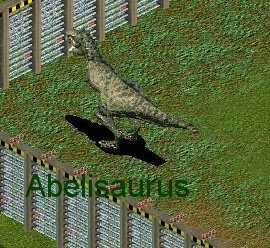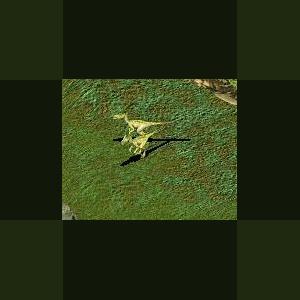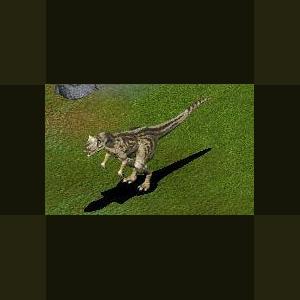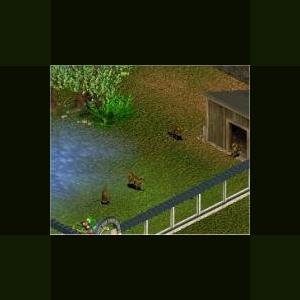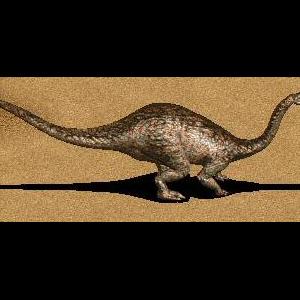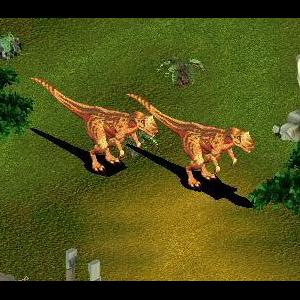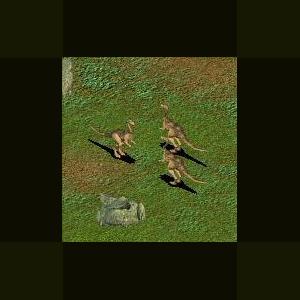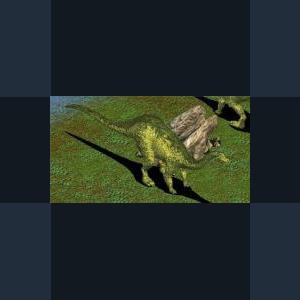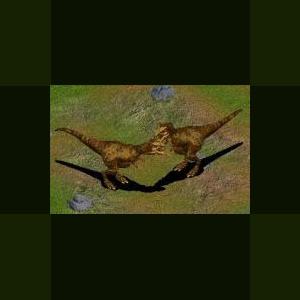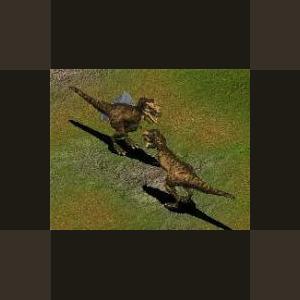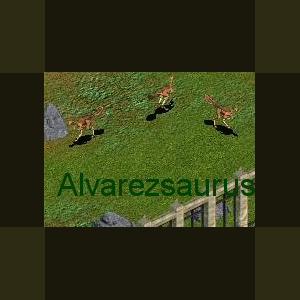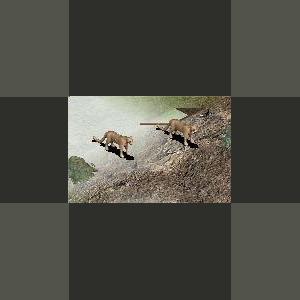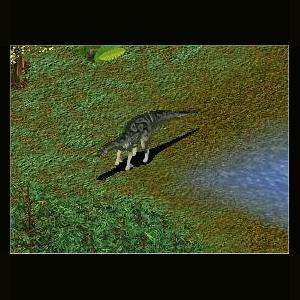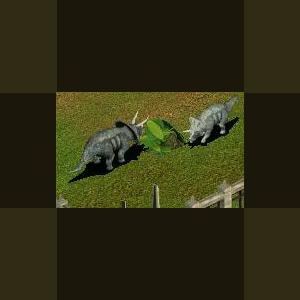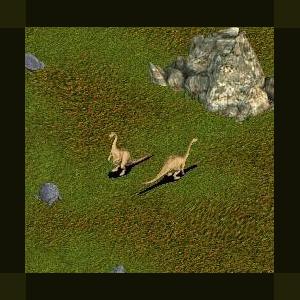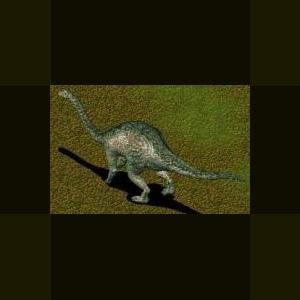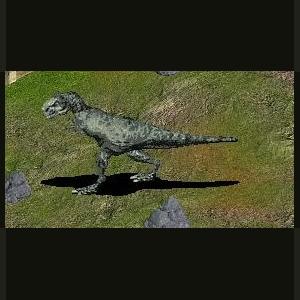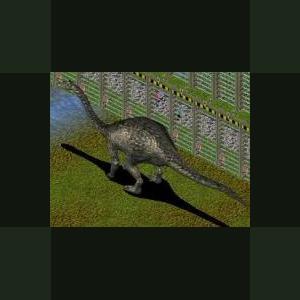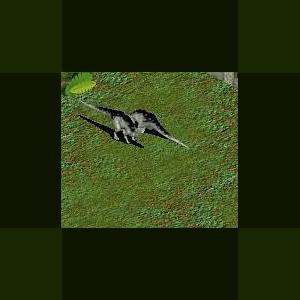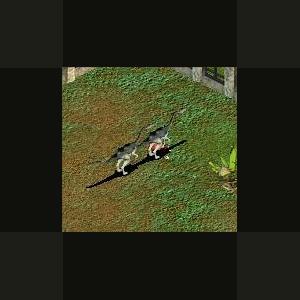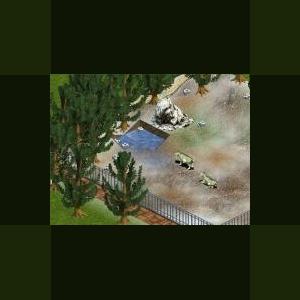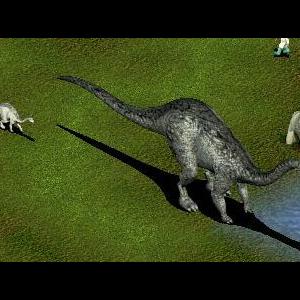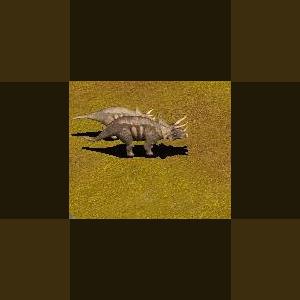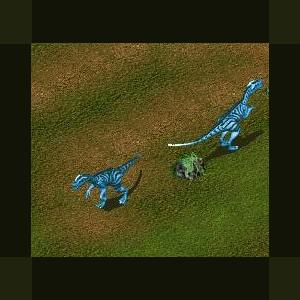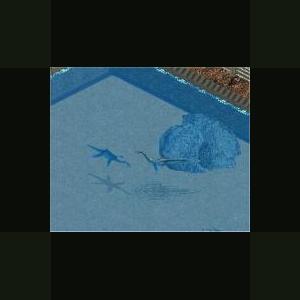Dinosaurs
Creatures from another age
241 files
-
Abelisaurus by Moondawg
By Savannahjan
Abelisaurus ("Abel's lizard") is a genus of abelisaurid theropod dinosaur from the Late Cretaceous Period of what is now South America.
The generic name recognizes Roberto Abel as the discoverer of the specimen and former director of the provincial Museum of Cipolletti in Argentina, where the specimen is housed. It also incorporates the Greek sauros, meaning 'lizard'. There is one named species, A. comahuensis, which honors the Comahue region of Argentina, where the fossil was found. Both genus and species were named and described by Argentine paleontologists Jose Bonaparte and Fernando Novas in 1985, who placed it in the newly-created family Abelisauridae.
Many other abelisaurids have since been discovered, including extremely complete specimens of Aucasaurus, Carnotaurus and Majungasaurus. Some scientists place Abelisaurus as a basal abelisaurid, outside the subfamily Carnotaurinae. Others are less certain of its position.Abelisaurids share some skull features with the unrelated carcharodontosaurids and, since Abelisaurus is known only from a skull, future discoveries may show that this genus was in fact a carcharodontosaurid. However, this is thought unlikely.
The one known fossil skull of Abelisaurus is incomplete, especially on the right side. It is also missing most of the palate (roof of the mouth). Despite the missing pieces, it is over 85 centimeters (33 inches) long. Although there are no bony crests or horns, like those found in some other abelisaurids, such as Carnotaurus, rough ridges on the snout and above the eyes might have supported some kind of crest made out of keratin, which wouldn't have become fossilized. There are also very large fenestrae (window-like openings) in the skull, which are found in many dinosaurs and reduce skull weight
Abelisaurus is one of the many dinosaurs that have been discovered in Patagonia. It was originally described as coming from the Allen Formation but subsequent research proved the remains were actually found in the older Anacleto Formation (part of the Neuquén Group) of Rio Negro Province, Argentina. The Anacleto is a geologic formation in South America, dating from the early Campanian stage of the Late Cretaceous Period, between 83 and 80 million years ago.
107 downloads
Updated
-
Achillobator by Moondawg
By Guest
Achillobator (meaning "Achilles' warrior/hero") is a genus of dromaeosaurid theropod dinosaur from the late Cretaceous Period of what is now Mongolia.
Fossil bones of Achillobator were found mostly disarticulated, but associated, including a fragment of the upper jaw with teeth, as well as vertebrae from all sections of the spinal column, ribs, and bones from the shoulder, pelvis, forelimbs and hindlimbs. These remains were found in the Bayan Shireh Formation of Dornogovi Province, Mongolia, which dates to the Late Cretaceous epoch. The exact age is uncertain, with two competing hypotheses; based on comparisons with other formations, the Bayan Shireh fauna seems to correspond best with the Turonian through early Campanian stages of the Late Cretaceous, about 93 to 80 million years ago. However, examination of the magnetostratigraphy of the formation seems to confirm that the entire Bayan Shireh lies within the Cretaceous Long Normal, which lasted only until the end of the Santonian stage, giving a possible Cenomanian through Santonian age, or between 98 and 83 million years ago. Other dinosaurs found in the Bayan Shireh include Alectrosaurus, Segnosaurus, Talarurus, and Bactrosaurus
361 downloads
Updated
-
Acrocanthosaurus by Moondawg
By Guest
Acrocanthosaurus (pronounced ak-ro-KAN-tho-SAWR-us; meaning 'high-spined lizard') is a genus of allosauroid theropod dinosaur that existed in what is now North America during the mid-Cretaceous Period
The skull of Acrocanthosaurus, like most other allosauroids, was long, low and narrow. The weight-reducing opening in front of the eye socket (antorbital fenestra) was quite large, more than a quarter of the length of the skull and two-thirds of its height. The outside surface of the maxilla (upper jaw bone) and the upper surface of the nasal bone on the roof of the snout were not nearly as rough-textured as those of Giganotosaurus or Carcharodontosaurus. Long, low ridges arose from the nasal bones, running along each side of the snout from the nostril back to the eye, where they continued onto the lacrimal bones. This is a characteristic feature of all allosauroids. Unlike Allosaurus, there was no prominent crest on the lacrimal bone in front of the eye. The lacrimal and postorbital bones met to form a thick brow over the eye, as seen in carcharodontosaurids and the unrelated abelisaurids. Nineteen curved, serrated teeth lined each side of the upper jaw, but a tooth count for the lower jaw has not been published. Acrocanthosaurus teeth were wider than those of Carcharodontosaurus and did not have the wrinkled texture that characterized the carcharodontosaurids. The dentary (tooth-bearing lower jaw bone) was squared off at the front edge, as in Giganotosaurus, and shallow, while the rest of the jaw behind it became very deep. Acrocanthosaurus and Giganotosaurus shared a thick horizontal ridge on the outside surface of the surangular bone of the lower jaw, underneath the articulation with the skull.
498 downloads
Updated
-
Aegyptopithecus by Ghirin
By Guest
Aegyptopithecus by Ghirin
Aegyptopithecus was an early hominid that lived in what is now modern day Egypt.
At that time, Egypt was much more wet and humid.
Reference:
http://www.johnhawks.net/weblog/fossils/ap...egyptopithecus/
263 downloads
0 comments
Updated
-
Aegyptosaurus by Moondawg
By Guest
Aegyptosaurus meaning 'Egypt’s lizard', where it was discovered is a genus of dinosaur believed to have lived in what is now Africa, around 95 million years ago, during the mid- and late-Cretaceous Period.
362 downloads
0 comments
Updated
-
Afrovenator by Moondawg
By Guest
Afrovenator ("African hunter") is a genus of megalosaurid theropod dinosaur from the Early Cretaceous Period of northern Africa.
It was a bipedal predator, with a mouthful of sharp teeth and three claws on each hand. Judging from the one skeleton known, this dinosaur was approximately 30 feet (9 meters) long from snout to tail tip.
The generic name comes from the Latin prefix afro- ("from Africa") venator ("hunter"). There is one named species, A. abakensis. The name refers to its predatory nature, and its location in Africa, specifically from In Abaka, the Tuareg name for the region of Niger where the fossils were found. The original description of both genus and species is found in a 1994 paper which appeared in the prestigious journal Science. The primary author was well-known American paleontologist Paul Sereno, with Jeffrey Wilson, Hans Larsson, Didier Dutheil, and Hans-Dieter Sues as coauthors.
The remains of Afrovenator were discovered in the Tiourarén Formation of the department of Agadez in Niger. The Tiourarén most likely represents the Hauterivian to Barremian stages of the Early Cretaceous Period, or approximately 136 to 125 million years ago (Sereno et al. 1994). The sauropod Jobaria, whose remains were first mentioned in the same paper which named Afrovenator, is also known from this formation.
Afrovenator is known from a single nearly complete skeleton, featuring most of the skull (minus the mandible, or lower jaw), parts of the spinal column, hands, and forelimbs, a nearly complete pelvis, and complete hind limbs. This skeleton is housed at the University of Chicago.
Most analyses place Afrovenator within Megalosauridae, which was formerly a "wastebasket family" which contained many large and hard-to-classify theropods, but has since been redefined in a meaningful way, as a sister taxon to the family Spinosauridae within the Spinosauroidea.
A 2002 analysis, focused mainly on the noasaurids, found Afrovenator to be a basal megalosaurid. However, it did not include Dubreuillosaurus (formerly Poekilopleuron valesdunesis), which could affect the results in that region of the cladogram (Carrano et al. 2002).
Other recent, more complete, cladistic analyses show Afrovenator in a subfamily of Megalosauridae with Eustreptospondylus and Dubreuillosaurus. This subfamily is either called Megalosaurinae (Allain 2002) or Eustreptospondylinae (Holtz et al. 2004). The latter study also includes Piatnitzkysaurus in this subfamily.
A few alternative hypotheses have been presented for Afrovenator's relationships.
398 downloads
Updated
-
Agilisaurus by Moondawg
By Guest
Acrocanthosaurus (pronounced ak-ro-KAN-tho-SAWR-us; meaning 'high-spined lizard') is a genus of allosauroid theropod dinosaur that existed in what is now North America during the mid-Cretaceous Period
The skull of Acrocanthosaurus, like most other allosauroids, was long, low and narrow. The weight-reducing opening in front of the eye socket (antorbital fenestra) was quite large, more than a quarter of the length of the skull and two-thirds of its height. The outside surface of the maxilla (upper jaw bone) and the upper surface of the nasal bone on the roof of the snout were not nearly as rough-textured as those of Giganotosaurus or Carcharodontosaurus. Long, low ridges arose from the nasal bones, running along each side of the snout from the nostril back to the eye, where they continued onto the lacrimal bones. This is a characteristic feature of all allosauroids. Unlike Allosaurus, there was no prominent crest on the lacrimal bone in front of the eye. The lacrimal and postorbital bones met to form a thick brow over the eye, as seen in carcharodontosaurids and the unrelated abelisaurids. Nineteen curved, serrated teeth lined each side of the upper jaw, but a tooth count for the lower jaw has not been published. Acrocanthosaurus teeth were wider than those of Carcharodontosaurus and did not have the wrinkled texture that characterized the carcharodontosaurids. The dentary (tooth-bearing lower jaw bone) was squared off at the front edge, as in Giganotosaurus, and shallow, while the rest of the jaw behind it became very deep. Acrocanthosaurus and Giganotosaurus shared a thick horizontal ridge on the outside surface of the surangular bone of the lower jaw, underneath the articulation with the skull.
244 downloads
Updated
-
Alamosaurus by Moondawg
By Guest
Alamosaurus, ("meaning "Alamo lizard"), is a genus of titanosaurian sauropod dinosaur from the Late Cretaceous Period of what is now North America.
Contrary to popular assertions, this dinosaur is not named after the Alamo in San Antonio, Texas, or the battle that was fought there. The holotype, or original specimen, was discovered in New Mexico and, at the time of its naming, Alamosaurus had not yet been found in Texas. Instead, the name Alamosaurus comes from Ojo Alamo, the former name for the geologic formation in which it was found (that part of the Ojo Alamo Formation has since been reassigned to Kirtland Shale) and which was, in turn, named after the nearby Ojo Alamo trading post. The term alamo itself is a Spanish word meaning "poplar" and is used for the local subspecies of cottonwood tree. The term saurus is derived from saura , Greek for "lizard" and is the most common suffix used in dinosaur names. There is one species (A. sanjuanensis), which is named after San Juan County, New Mexico, where the first remains were found. Both genus and species were named by Smithsonian paleontologist Charles W. Gilmore in 1922.
Alamosaurus is undoubtedly a derived member of Titanosauria, but relationships within that group are far from certain. One major analysis unites Alamosaurus with Opisthocoelicaudia in a subfamily Opisthocoelicaudinae of the family Saltasauridae (Wilson, 2002). A major competing analysis finds Alamosaurus as a sister taxon to Pellegrinisaurus, with both genera located just outside Saltasauridae (Upchurch et al., 2004). Other scientists have also noted particular similarities with the saltasaurid Neuquensaurus and the BrazilianTrigonosaurus (the "Peiropolis titanosaur") which is used in many cladistic and morphologic analyses of titanosaurians (Lehman and Coulson, 2002).
391 downloads
0 comments
Updated
-
Albertosaurus by Moondawg
By Guest
Albertosaurus (pronounced ; meaning 'Alberta lizard') is a genus of tyrannosaurid theropod dinosaur that lived in western North America during the Late Cretaceous Period,
As a tyrannosaurid, Albertosaurus was a bipedal predator with tiny, two-fingered hands and a massive head with dozens of large, sharp teeth. It may have been at the top of the food chain in its local ecosystem. Although relatively large for a theropod, Albertosaurus was much smaller than its more famous relativeTyrannosaurus, probably weighing less than 2 metric tons.
Fossils of more than thirty individuals have been recovered, providing scientists with a more detailed knowledge of Albertosaurus anatomy than is available for most other tyrannosaurids. The discovery of 22 individuals at one site provides evidence of pack behavior and allows studies of ontogeny and population biology which are impossible with
lesser-known dinosaurs
455 downloads
Updated
-
Alioramus by Moondawg
By Guest
Alioramus ( meaning 'different branch') is a genus of tyrannosaurid theropod dinosaur from the Late Cretaceous Period of Asia.
The type and only species, A. remotus, is known from a partial skull and three metatarsals recovered from Mongolian sediments which were
deposited in a humid floodplain between 70 to 65 million years ago. These remains were
named and described by Russian paleontologist Sergei Kurzanov in 1976. Its relationships
to other tyrannosaurid genera are unknown, but some experts believe Alioramus is closely
related to the contemporaneous Tarbosaurus, or is a juvenile of that genus.
While very little skeletal material is known, Alioramus was probably bipedal like most
theropods, and its sharp teeth indicate that it was a carnivore. It was smaller than
tyrannosaurids like Tarbosaurus and Tyrannosaurus, but its adult size is difficult to
estimate since it is known mainly from a skull, which may belong to a juvenile. Alioramus
is characterized by the row of five bony crests along the top of its snout, and also has
more teeth than any other tyrannosaurid. Its skull is lower than those of other
tyrannosaurids, but this might be a juvenile feature.
Alioramus was estimated at between 5 and 6 meters (16.5 to 20 ft) in length when
originally described by Sergei Kurzanov in 1976. Kurzanov, however, did not correct for
lengthening of the skull by deformation during fossilization, which may indicate a shorter
overall body length for this individual. If this specimen is a juvenile, then adult
Alioramus would have reached greater lengths, but no confirmed adult specimens are known.
Inspired by the Zoo Tek Brains Trust
293 downloads
Updated
-
Alvarezsaurus by Moondawg
By Guest
The Alvarezsauridae are an enigmatic family of small, long-legged running dinosaurs. Although originally thought to represent the earliest known flightless birds, a consensus of recent work suggests that they are primitive members of the Maniraptoriformes. Other work found them to be the sister group to the Ornithomimosauria. Alvarezsaurs are highly specialized. They bear tiny but stoutly proportioned forelimbs with compact birdlike hands and their skeleton suggests they had massive breast and arm muscles, possibly adapted for digging or tearing. They have tubular snouts, elongate jaws, and minute teeth. They may have been adapted to prey on colonial insects such as termites. Alvarezsaurids range from 0.5.2 m (20-80 inches) in length, although some possible members may have been substantially larger, including the European Heptasteornis (also called Elopteryx) that may have reached 2.5 m (8 ft).
At least one species of Alvarezsaurid, Shuvuuia deserti, has down-like, feathery, integumental structures that are preserved in the fossil. Schweitzer et al. (1999) subjected these filaments to microscopic, morphological, mass spectrometric, and immunohistochemical studies and found that they consisted of beta Keratin, which is the primary protein in feathers.
Alvarezsaurus, and thus Alvarezsaurinae, Alvaresauridae, and Alvarezsauria are named for the historian Don Gregorio Alvarez, not the more familiar physicist Luis Alvarez, who proposed that the Cretaceous-Tertiary extinction event was caused by an impact event.
The type species is A. calvoi. It was bipedal, had a long tail and its leg structure suggests that it was a fast runner. It may have been insectivorous and was basal to better-known members of its family, such as Mononykus and Shuvuuia. It has been alternately classified with both non-avian theropod dinosaurs and early birds
268 downloads
Updated
-
American Lion by Moondawg
By Guest
The American lion (Panthera leo atrox) also known as the North American or American cave lion, is an extinct feline known from fossils.
It was one of the largest subspecies of lion to have ever existed, comparable in size to the Early Middle Pleistocene primitive
cave lion Panthera leo fossilis and was about 25% larger than the modern African lion.
The American lion is an extinct animal which originated in North America and went on to
colonize part of South America as part of the Great American Interchange. The body length
of the American lion is estimated to have been 1.6-2.5 m (5.25-8.20 feet). Thus it was
comparable in size to its close relative, the extinct lion, Panthera leo fossilis, or the
modern species of Siberian tiger, but still smaller than their contemporary competitor for
prey, the Giant short-faced bear, which was the largest carnivoran of their era.
Approximately one hundred specimens of American lions have been recovered from the La Brea
Tar Pits, in Los Angeles, so their body structure is well known. The features and teeth of
the extinct American lion strongly resemble modern lions, but they were considerably larger.
South of Alaska, the American lion first appeared during the Sangamonian (the last
interglacial). After that it was widespread in the Americas from Alaska to Peru, although
it was absent from eastern North America and peninsular Florida. As did many other large
mammals, it went extinct at the end of the Pleistocene, about 10,000 years ago. By then
the American lion was one of the abundant Pleistocene megafauna, a wide variety of very
large mammals who lived during the Pleistocene. Remains are most common in the Yukon and
from the La Brea Tar Pits.
565 downloads
0 comments
Updated
-
Anatotitan by Ghirin
By Guest
Anatotitan
Author: Ghirin
Anatotitan ("Giant Duck") was a large flat-headed hadrosaur from North America. In older literature, Anatotitan was listed as Anatosaurus or Trachodon.
*Inspired by the Zoo Tycoon Brain Trust at the Zoo Tek Evolved Forums
490 downloads
0 comments
Updated
-
Anchiceratops by Moondawg
By Guest
American paleontologist Barnum Brown named Anchiceratops in 1914, as he believed Anchiceratops was a transitional form closely related to both Monoclonius and Triceratops and intermediate between them.
There is one valid species known today (A. ornatus), whose name refers to the ornate margin of its frill. A second species was named A. longirostris by Charles M. Sternberg in 1929, but this species is widely considered a junior synonym of A. ornatus today.
The first remains of Anchiceratops were discovered along the Red Deer River in the Canadian province of Alberta in 1912 by an expedition led by Barnum Brown.The holotype is the back half of a skull, including the long frill,and several other partial skulls were found at the same time, which are now stored in the American Museum of Natural History in New York City. A complete skull was discovered by C.M. Sternberg in 1924, and described as A. longirostris five years later. Another specimen, collected by Sternberg in 1925, lacks the skull but is otherwise the most complete skeleton known from any ceratopsid, preserving a complete spinal column down to the last tail vertebra. Sternberg's material is now housed in the Canadian Museum of Nature in Ottawa. Other material has been found since, including one or two bonebed deposits in Alberta, but very little Anchiceratops material has been described.
Anchiceratops ornatus.Anchiceratops frills are very distinctive. Rectangular in shape, the frill is edged by large epoccipitals (triangular bony projections), and has smaller fenestrae (window-like openings) than those seen in other chasmosaurines like Pentaceratops and Torosaurus.Another characteristic feature is the pair of bony knobs located on either side of the midline, towards the end of the frill.
Most Anchiceratops fossils have been discovered in the Horseshoe Canyon Formation of Alberta, which belongs to the early part of the Maastrichtian stage of the Late Cretaceous Period (74-70 million years ago). Frill fragments found in the early Maastrichtian Almond Formation of Wyoming in the United States resemble Anchiceratops (Farke, 2004). However, pieces of a frill have been found from two localities in the older Dinosaur Park Formation (late Campanian, 78-74 million years ago) with the characteristic pattern of points seen in Anchiceratops frills. This may represent an early record of A. ornatus or possibly a second, related species (Langston, 1959).
474 downloads
0 comments
Updated
-
Anchisaurus by Moondawg
By Guest
Anchisaurus (from Greek anchi-; "near, close" + Greek sauros; "lizard", probably referring to Marsh's interpretation of it as intermediate between more primitive dinosaurs [at the time Palaeosaurus was an example of what was thought to be a primitive dinosaur] and more derived dinosaurs) is a genus of prosauropod dinosaur. The name Anchisaurus was coined as a replacement name for Amphisaurus, which was a replacement name for Hitchcock's Megadactylus, both of which had already been used for other animals.
The first discovery of Anchisaurus remains was made before anything was known about dinosaurs and it was probably the first dinosaur discovery in North America. When, in 1818, some large bones were discovered in Connecticut, USA, it was assumed that they were of human origin.Gradually, as a result of further finds in Massachusetts, the number of these bones began to accumulate and, by 1855, they were at least recognized as reptilian.
Hitchcock collected these bones under the name Megadactylus in 1865. Unfortunately, the name was in use, and the famous paleontologist Othniel Charles Marsh renamed it Anchisaurus in 1885. Remains thought to belong to this genus were found in South Africa and China, adding to the theory that these land masses were at the time joined in one super-continent, Pangaea, but these assignments have been contentious (Gyposaurus). A recovery from Nova Scotia may also be an Anchisaurus but this is unconfirmed.
Today, parts of Anchisaurus' skeleton are still missing. Reconstructions usually assume that the tail and neck were prosauropod-like. Recent analyses, however, put Anchisaurus firmly at the base of the Sauropoda, making it the most basal known sauropod.
Anchisaurus was a rather small dinosaur, with a length of just over 2 metres (6.6 ft), which helps explain why it was once mistaken for human bones. It probably weighed around 27 kilograms (60 lb). However, Marsh's species A. major (also known as Ammosaurus) was larger, from 2.5 to 4 metres (8 ft 2 in to 13 ft 1 in) and some estimates give it a weight of up to 70 pounds (32 kg). All species of Anchisaurus lived during the Early Jurassic Period; more specifically, the Pliensbachian to Toarcian ages, 200 to 188 million years ago.
Digesting plant matter is a much more intensive biochemical process than digesting meat. This herbivore swallowed gastroliths (gizzard stones) to help break down the food in its stomach. Herbivorous dinosaurs needed a huge gut. Since this had to be positioned in front of the pelvis, balancing on two legs became increasingly difficult, as dinosaurs became larger and they gradually evolved into the quadrupedal position that characterizes the later sauropods such as Diplodocus. Prosauropods represented a middle phase between the earliest bipedal herbivores and the later giant sauropods. Although it was not itself a prosauropod, Anchisaurus was mostly typical of this group, which flourished briefly during the late Triassic and early Jurassic. Anchisaurus teeth, used to rip food, were shaped like spoons. It had fewer and more widely spaced teeth than true prosauropods, and as Peter Galton and Michael Cluver observed, narrower feet. Anchisaurus would have spent most of its time on four legs but could have reared up on its hind legs to reach higher plants.
On the other hand, some paleontologists believe Anchisaurus may also have eaten meat, as it was in the transition between these two ultimately distinct groups. The teeth were blunt but with file-like edges, suggesting mostly plant matter was eaten and the jaw hinge was arranged in a way not entirely suited for tearing meat. Nevertheless, there is still some debate. The thumb had a large claw and the large eyes were not entirely on the side (as would be expected in an animal of a natural prey species).
As a quadrupedal/bipedal crossover, Anchisaurus had to have multi-purpose front legs. As 'hands', they could be turned inwards and be used for grasping. It had a simple reversible first 'finger', similar to a 'thumb'. As feet, the five toes could be placed flat against the floor and were strong at the ankle. This unspecialized design is typical of the early dinosaurs.
Due to its primitive appearance, Anchisaurus was previously classified as a prosauropod, a member of a group of animals related to or ancestral to the sauropods. Recent investigations show that Prosauropoda forms a monophyletic sister-group to Sauropoda and that Anchisaurus is instead a very basal sauropod.
Marsh was originally happy with Hitchcock's name Megadactylus but this name was already taken. Therefore, he renamed it Amphisaurus in 1882. However, this name was also already in use and therefore, it became Anchisaurus in 1885.
The type species is Hitchcock's A. polyzelus. Marsh's A. major ("greater near lizard") is still often considered a valid species (as Ammosaurus) but his A. colurus (1891), once known as Yaleosaurus (von Huene, 1932), is now generally accepted as a female A. polyzelus, and his A. solus of 1892 is now reclassified as Ammosaurus major. However, Ammosaurus major itself may well be a synonym of A. polyzelus.
Broom named Gyposaurus capensis in 1911, from the bones discovered in South Africa but Peter Galton officially renamed it A. capensis in 1976. This species has since been reclassified again and is probably a juvenile of Massospondylus carinatus. G. sinensis was also referred here, but appears to be a distinct animal. Other specimens are still awaiting reclassification. This confusion is typical of the first dinosaurs to be discovered, when classification was not considered as important and precise a process as today.
344 downloads
Updated
-
Antarctosaurus by Moondawg
By Guest
Antarctosaurus (pronounced as ; meaning "southern lizard") is a genus of titanosaurian sauropod dinosaur from the Late Cretaceous Period of what is now South America.
Antarctosaurus was very large, even for a dinosaur. Scientists still have much to learn about Antarctosaurus, as a complete skeleton remains elusiveAntarctosaurus was a huge quadrupedal herbivore with a long neck and tail. It was possibly armored. As Antarctosaurus is not known from a complete skeleton[1] and tail lengths are highly variable among sauropods, the true size of these animals is hard to extrapolate. The type species may have been over 60 feet (18 meters) long, and a second species may have been one of the largest land animals ever. Antarctosaurus may have been as tall as 15 feet at the shoulder.
Remains of this dinosaur were first mentioned in print in 1916, although they were not fully described and named until a 1929 manuscript written by paleontologist Friedrich von Huene. Antarctosaurus does not refer to the continent of Antarctica, since it was first found in Argentina, although it does have the same derivation, from the Greek words anti- meaning 'opposite of', arktos meaning 'north' and sauros meaning 'lizard'. The generic name refers to the animal's reptilian nature and its geographical location on a southern continent.r
278 downloads
0 comments
Updated
-
Appalachiosaurus by Moondawg
By Guest
Appalachiosaurus
Appalachiosaurus (pronounced ap-a-LAYCH-ee-oh-SAWR-us; "Appalachian lizard") is a genus of tyrannosauroid theropod dinosaur from the Late Cretaceous Period of eastern North America. Like almost all theropods, it was a bipedal predator. Only a juvenile skeleton has been found, representing an animal over 7 meters (23 ft) long and weighing over 600 kilograms (1300 lb), which indicates an adult would have been even larger. This species is notable as the most completely known theropod from the eastern part of North America.
This dinosaur was named after the region of the central United States known as Appalachia, which also gave its name to the ancient island continent on which Appalachiosaurus lived. Both are named after the Appalachian Mountains. The generic name also includes the Greek word sauros ("lizard"), the most common suffix used in dinosaur names. There is one known species, A. montgomeriensis, which is named after Montgomery County in the U.S. state of Alabama. Both genus and species were named in 2005 by paleontologists Thomas Carr, Thomas Williamson, and David Schwimmer (who is not to be confused with the actor of the same name).
Fossils of Appalachiosaurus were found in central Alabama, from the Demopolis Chalk Formation. This formation dates to the middle of the Campanian stage of the Late Cretaceous, or around 77 million years ago (Carr et al., 2005).
Appalachiosaurus is so far known from only partial remains, including parts of the skull and mandible (lower jaw), as well as several vertebrae, parts of the pelvis, and most of both hindlimbs. These remains are housed at the McWane Science Center in Birmingham, Alabama. There are several open sutures between bones of the skull, indicating that the animal was not an adult. Several elements are crushed, but the specimen is still informative and shows many unique characteristics, or apomorphies. Several of these apomorphies have been identified in the skull, and the claws of the feet show an unusual protrusion on the end closest to the body. A row of six low crests lines the top of the snout, similar to the Asian Alioramus, although most tyrannosaur species exhibit ornamentation to varying degrees on top of the snout. Appalachiosaurus is significantly different and more derived than another early tyrannosaur from eastern North America, Dryptosaurus.
Appalachiosaurus is complete enough to be included in phylogenetic analyses using cladistics. The first was performed before the animal had had even been named, and found Appalachiosaurus to be a member of the albertosaurine subfamily of Tyrannosauridae, which also includes Albertosaurus and Gorgosaurus (Holtz, 2004). The original description also included a cladistic analysis, finding A. montgomeriensis to be a basal tyrannosauroid outside of Tyrannosauridae (Carr et al., 2005). However, Asian tyrannosaurs like Alioramus, and Alectrosaurus were excluded, as was Eotyrannus from England. Earlier tyrannosaurs such as Dilong and Guanlong had not been described at the time this analysis was performed. These exclusions may have a significant effect on the phylogeny. To date, no analysis has been published which includes all known tyrannosauroid taxa.
346 downloads
0 comments
Updated
-
Aragosaurus by Moondawg
By Guest
Aragosaurus (meaning "Aragon lizard") was a genus of sauropod dinosaur from the Early Cretaceous period of Galve, Teruel, in the province of Aragón, Spain.
Aragosaurus was a large, quadrupedal plant-eating (herbivorous) dinosaur, which lived about 130-120 million years ago, in the Hauterivian-Barremian. It was about 60 ft (18 m) in length and about 28000 kg in weight.
Like other sauropods, it had a long neck, a long powerful tail, a small head and a bulky body. It was broadly similar to Camarasaurus. It is represented by a partial fossil, which was found in Spain and was named by Sanz, Buscalioni, Casanovi and Santafe in 1987. The type species is A. ischiaticus. Like Camarasaurus, Aragosaurus probably had a short, compact skull and a moderately long neck. The teeth were large and wide, and would have been useful for slicing through the leaves and branches of tall conifer trees. The forelimbs were only a little shorter than the hind limbs, and the tail was long and muscular.
316 downloads
0 comments
Updated
-
Aralosaurus by Moondawg
By Guest
Aralosaurus (ar-ahl-o-SORE-us) meaning "Aral Sea lizard", because it was found in the Aral Sea when it began to shrink noticeably.Aralosaurus was a genus of hadrosaurid dinosaur which lived during the Late Cretaceous of what is now Kazakhstan.
Aralosaurus was characterized by a small, bony peak on its nose, much like its relatives Maiasaura and Gryposaurus. Some paleontologists have posited that Aralosaurus was actually a lambeosaurine.
Aralosaurus was a herbivore that lived in the late Cretaceous period, around 95 to 80 million years ago, and was capable of both bipedal and quadrupedal movement. Egg clusters show that Aralosaurus lived in herds and had locations for laying eggs where they would be safe.Several relatives, such as Jaxartosaurus have also been found in the surrounding area where Aralosaurus was found.
Aralosaurus was about the size of an elephant, being up to 9 m long, but was over 5,000 kilograms in weight. Although very little is known about Aralosaurus (only one near complete skull has been found); it was identified by a beak with nearly 1,000 small teeth in 30 rows. These teeth were used for breaking up plant matter by chewing, a feature common in herbivorous dinosaurs, but unusual for reptiles.The back of an Aralosaurus skull was wide, a feature suggestive of large jaw muscles used to power its chewing apparatus
340 downloads
0 comments
Updated
-
Archaeornithoides by Moondawg
By Guest
Archaeornithoides is a genus of maniraptoriform theropod dinosaur. It was found in Late Cretaceous river sandstones of the Djadokhta Formation beds located in Bayn Dzak,Mongolia.
The generic name (Archaeornithoides) means “shaped like an ancient bird” in ancient Greek. The specific descriptor (deinosauriscus) alludes to the animal's small size for a dinosaur.
Elzanowski & Wellnhofer (1993) suggested that Archaeornithoides was the closest known relative to birds Avialae. This conclusion rested on key bird-like features; an interdigitated suture between the premaxilla and maxilla, broad palatal shelves, pneumatic sinuses, lack of interdental plates, and unserrated teeth. Since publication, though, all of these features have been discovered in new fossils of adult and/or juvenile troodonts and dromaeosaurs.
Elzanowski and Wellnhofer noted that the specimen has distinct bite marks, and suggested that its braincase was bitten off by a deltatheridiid (Deltatheridium) mammal the size of a weasel (adding that these are common in the Bayn Dzak assemblage). Clark and colleagues (2002) noted that it may have also passed through the digestive tract of the predator before fossilization. If true, this may be the first known evidence of Mesozoic mammals eating dinosaurs (see Repenomamus).
287 downloads
0 comments
Updated
-
Arctic Homotherium Serum by Ghirin
By Guest
The saber-toothed cats were one of the major branches of the prehistoric felines.
The genus Homotherium contained lion-sized felines with laterally flattened canines, unlike the conical canines of modern cats. Homotherium fossils have been found in both Pleistocene North America (H. serum) and Eurasia (H. latidens) and these cats were probably specialists in hunting young pachyderms such as mammoths.
White variants naturally occur in todays lion and tiger populations, but such a color is usually a disadvantage. However, a pale coat might have been an advantage to populations of Homotherium living in areas with extensive snow cover (Alaska, Siberia).
479 downloads
0 comments
Updated
-
Argentinosaurus by Moondawg
By Guest
Argentinosaurus (meaning "Argentina lizard") was a herbivorous sauropod dinosaur genus that was quite possibly the largest, heaviest land animal that ever lived. It developed on the island continent of South America during the middle of the Cretaceous Period (around 100 million years ago), after all of its more familiar Laurasian Jurassic kin — like Apatosaurus — had long disappeared.
Not much of Argentinosaurus has been recovered: just some back vertebrae, tibia, fragmentary ribs, and sacrum. One vertebra had a length of 1.3 meters and the tibia was about 155 centimeters (58 inches). However, the spectacular proportions of these bones and comparisons with other sauropod relatives allow paleontologists to estimate the size of the animal. Early reconstructions estimated Argentinosaurus at 35 meters (115 ft) in length and a weight of perhaps 80 to 100 tonnes. More recent estimates based on Saltasaurus, Opisthocoelicaudia and Rapetosaurus suggest sizes around 22-26 meters (72 - 85 ft).[1] It is the largest dinosaur for which there exists good evidence. Although it might have been smaller than Bruhathkayosaurus, which may have reached 44 meters (144 ft) in length and weighed 180 tons (however like Argentinosaurus it has been estimated shorter, at 28-34 meters (92-112 ft)), as well as the poorly known Amphicoelias fragilimus, which may have been up to 60 meters (200 ft) long, these estimates cannot be validated due to lack of evidence.
Vast wings on the vertebrae suited the attachment of massive muscles
The type species of Argentinosaurus, A. huinculensis, was described and published (by the Argentinian palaeontologists José F. Bonaparte and Rodolfo Coria) in 1993. Its more specific time-frame within the Cretaceous is the Albian to Cenomanian epochs, 112.2 to 93.5 million years ago. The fossil discovery site is in the Río Limay Formation in Neuquén Province, Argentina
Argentinosaurus is featured prominently in the permanent exhibition Giants of the Mesozoic at Fernbank Museum of Natural History in Atlanta, Georgia, USA. This display depicts a hypothetical encounter between Argentinosaurus and the carnivorous theropod dinosaur Giganotosaurus. Contemporary fossils of Cretaceous Period plants and animals are included in the exhibition, including two species of pterosaurs, providing a snapshot of a prehistoric ecosystem in what is now the modern Patagonia region of Argentina. At 123 feet (37 m) long, this skeletal reconstruction represents the largest dinosaur mount ever to be assembled.
634 downloads
0 comments
Updated
-
Arrhinoceratops by Moondawg
By Guest
Arrhinoceratops belonged to the Ceratopsinae (previously known as Chasmosaurinae) within the Ceratopsia (the name is Ancient Greek for "horned face"), a group of herbivorous dinosaurs with parrot-like beaks which thrived in North America and Asia during the Cretaceous Period, which ended roughly 65 million years ago. It appears to be closely related to Torosaurus.
Since this dinosaur is known only from its skull, scientists know little about its over-all anatomy. The skull features a broad neck frill with two oval shaped openings.
Its brow horns were moderately long, but its nose horn was shorter and blunter than most Ceratopsians
Its body is assumed to be typical of the Ceratopsians, and based on the skull it is estimated to be 6 m (20 ft) long when fully grown.
Arrhinoceratops, like all Ceratopsians, was a herbivore. During the Cretaceous, flowering plants were "geographically limited on the landscape", and so it is likely that this dinosaur fed on the predominant plants of the era: ferns, cycads and conifers. It would have used its sharp Ceratopsian beak to bite off the leaves or needles.
368 downloads
0 comments
Updated
-
Atlascopcosaurus by Moondawg
By Guest
Atlascopcosaurus
Atlascopcosaurus (meaning "Atlas Copco lizard") is the name given to a genus of hypsilophodont dinosaur. It lived in what is now Australia; the type specimen, Atlascopcosaurus loadsi, was found at Dinosaur Cove in Victoria. It was about 2-3 metres (6.5-10 ft) long and weighed roughly 125 kg. It lived during the early Cretaceous (Aptian-Albian), but not much else is known about it; the genus is based on a mostly incomplete skeleton (the holotype consists of a piece of maxilla and teeth).
It was named after the Atlas Copco Company who had provided equipment for the expeditions that discovered this dinosaur in 1984. The project revealed 85 fossil bone fragments. This opened the door for more excavation and, along with other companies, Atlas Copco helped excavate about 60 metres of tunnel over 10 years.
The species name, loadsi, refers to William Loads, the state manager for Atlas Copco at the time, who assisted during the dig.
426 downloads
Updated
-
Attenborosaurusby Ghirin
By Guest
Attenborosaurus
Author: Ghirin
The genus Attenborosaurus was named in honor of British naturalist Sir David Attenborough. Its fossils were found in Europe and were originally classified as a species of Plesiosaurus.
Attenborosaurus is fully compatible with Cryptocleidus.
423 downloads
0 comments
Updated

